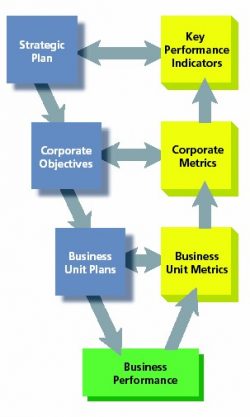KPIs: The Basics & Why Non-Financial Metrics Matter
 Key Performance Indicators (KPIs) provide an organization with a high-level snap-shot of the health of the business through a set of agreed-upon measures that reflect progress toward the achievement of corporate goals. They give executives and managers the ability to focus on what matters most to the company. They align all levels of an organization (business units, departments and individuals) with clearly defined and cascaded targets to create accountability and track progress. They promote collaborative planning across the organization to ensure that everyone is operating from the same page. And, they provide a starting point for the performance improvement process by demonstrating whether a business is in line with its strategic objectives.
Key Performance Indicators (KPIs) provide an organization with a high-level snap-shot of the health of the business through a set of agreed-upon measures that reflect progress toward the achievement of corporate goals. They give executives and managers the ability to focus on what matters most to the company. They align all levels of an organization (business units, departments and individuals) with clearly defined and cascaded targets to create accountability and track progress. They promote collaborative planning across the organization to ensure that everyone is operating from the same page. And, they provide a starting point for the performance improvement process by demonstrating whether a business is in line with its strategic objectives.
Getting Started with KPIs
When deploying performance metrics, we must begin with the end result in mind and focus on what we want as outcomes of our work processes. This often presents a challenge since we do not work as a set of isolated departments, but in collaboration with others. Processes that begin with an individual or department are continued or completed by others. So, how do we effectively measure outcomes when a single individual or group is not controlling all the key steps? How can individuals see what the effects of their improvements are if these get lost in the noise of company management reports?
One problem is that business processes are segmented, and many departments are collecting silos of information that produce metrics used only for the sake of measurement. These silos then reinforce divergent opinions of company performance and limit a common understanding of what new behaviors are needed. So, a major factor in implementing performance measurement is changing the way performance is measured and reported and how people view success within their own processes.
As with many management issues, the key to leveraging performance metrics is to do it in stages. Clear corporate goals are important, otherwise vague objectives will create impractical perspectives and metrics. Also consider current performance indicators: What is currently measured? How are these aligned with company objectives? For many, this lack of connectivity causes dissatisfaction with management reports and criticism of managers who simply “manage by the numbers.” The best way to build this relationship is to “map” front-line activities all the way up to corporate goals, with buy-in from all of your stakeholders, from executive- to plant-level lines of management .
What KPIs Should Do
 At a high level, key performance indicators should be structured to accomplish the following:
At a high level, key performance indicators should be structured to accomplish the following:- Address all aspects of performance results in the areas of customer satisfaction, product and service performance, financial and marketplace performance, supplier and partner results, operational performance, and performance relative to competitors.
- Reflect an enterprise perspective rather than stovepiped functional or business-focused views.
- Support strategic goals and describe the targeted performance in measurable, comprehensible and relevant terms based on valid data.
- Be deployed to the organizational level which has the authority, resources, and knowledge required to take necessary action.
- Cascade throughout the organization, empowering your employees and promoting positive action (often via linked compensation).
- Not be overwhelming to manage (they should not require full-time employees to monitor them).
- Include both financial and non-financial measures.
Why Non-Financial Measures Matter
The last point above is critical. Many companies launch their performance management initiatives solely with KPIs that are financial in nature; but unfortunately, such measures cannot be acted on. Non-financial measures, on the other hand, offer four clear advantages in driving performance improvement:
- First of these is a closer link to long-term organizational strategies. Financial evaluation systems generally focus on annual or short-term performance against accounting yardsticks. They do not deal with progress relative to customer requirements or competitors, or other non-financial objectives that may be important in achieving profitability, competitive strength and longer-term strategic goals.
- Second, critics of traditional measures argue that drivers of success in many industries are “intangible assets” such as intellectual capital and customer loyalty, rather than the “hard assets” found on balance sheets. Although it is difficult to quantify intangible assets in financial terms, non-financial data can provide indirect, quantitative indicators of a firm’s intangible assets.
- Third, non-financial measures can be better indicators of future financial performance. Even when the ultimate goal is maximizing financial performance, current financial measures may not capture long-term benefits from decisions made now.
- Finally, the choice of measures should be based on providing information about managerial actions. Managers must be aware of how much success is due to their actions or they will not have the signals they need to maximize their effect on performance. Because many non-financial measures are less susceptible to external noise than accounting measures, their use can improve managers’ performance by providing more precise evaluation of their actions.
In future posts, I’ll discuss the components of an effective KPI system, some proven methods for defining and delivering KPIs to key stakeholders throughout your business, along with examples of KPIs and associated metrics that Silvon has put into place for some of our clients in manufacturing and distribution.
 At a high level, key performance indicators should be structured to accomplish the following:
At a high level, key performance indicators should be structured to accomplish the following: